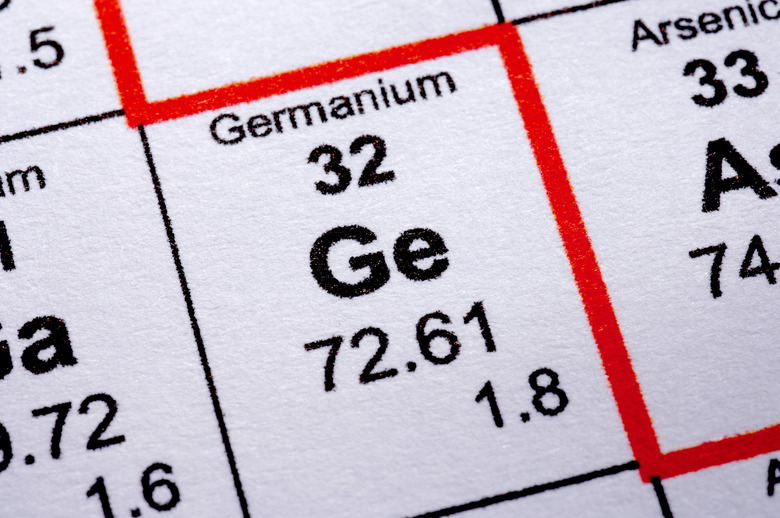The Conversion Factors Inherent In Chemical Formulas
Most chemical formulas involve subscripts that are numbers. While these numbers are not followed by units written in the formula, they are, in fact, quantities with units. Thus inherent in chemical formulas is the necessity of conversion factors, which are fractions that convert one unit to another when multiplied by a measurement. The process of using conversion factors is known as dimensional analysis, and it is vital to the study of chemical formulas and equations.
Moles of Compounds to Moles of Elements
Moles of Compounds to Moles of Elements
A mole is a unit of measurement of amount. If a whole number appears as a subscript in a chemical formula, it represents the number of moles of the element immediately preceding the subscript in the formula. If the subscript follows a set of parentheses, it represents the number of moles of the group of atoms in parentheses. The mole is useful because it helps you understand the relative amount of each element in a compound, and these amounts are given by the subscripts in the formula. For example, the formula for water is H2O, where the two is the subscript for hydrogen. There is no subscript after oxygen, which is the same thing as having a subscript of one. Therefore, one mole of the compound H2O contains two moles of hydrogen and one mole of oxygen, and the conversion factors are (2 moles hydrogen/ 1 mole H2O) and (1 mole oxygen/ 1 mole H2O), respectively.
Moles to Atoms and Molecules
Moles to Atoms and Molecules
The unit of a mole is useful not only because it breaks a formula down into its chemical components, but also because of its relation to the number of atoms and molecules. One mole is 6.02 * 10^23 atoms or molecules, so the conversion factor is (6.02 * 10^23 atoms or molecules/ 1 mole). For example, one mole of carbon is equal to 6.02 * 10^23 atoms of carbon, and one mole of carbon dioxide is equal to 6.02 * 10^23 molecules of carbon dioxide. Since the formula of carbon dioxide is CO2, one mole of carbon and two moles of oxygen can be found in one mole of carbon dioxide. Thus 6.02 * 10^23 carbon atoms and 12.04 * 10^23 oxygen atoms exist in one mole of carbon dioxide.
Moles to Grams
Moles to Grams
While it is important to understand moles and the number of atoms and molecules, a more practical unit for experiments is the gram, which is a unit of mass. You cannot measure a mole of a substance in a laboratory, but you can measure its mass in grams on a balance. The conversion factor for converting moles to grams comes from the periodic table. The atomic mass, which is usually given below the atomic symbol and atomic number, is the number of grams per mole of that element. For example, the atomic mass of germanium is 72.61 g/ mol. Therefore, the conversion factor is (72.61 g Ge / 1 mol Ge). The conversion factor for each element is analogous; simply replace the atomic mass of germanium with the atomic mass of the element being studied.
Percents to Moles
Percents to Moles
Sometimes the subscripts in chemical formulas are not whole numbers but decimals. These are percents, and it is often necessary to convert percents to moles. For example, if you have a compound whose constituents are given in percents, like C0.2H0.6O0.2, then 20 percent of the moles of the compound are carbon, 60 percent are hydrogen and 20 percent are oxygen. To convert to moles, find the factor that multiply by the smallest percent to get a product of 100 percent. In this case the smallest percent is 20 percent, so that number is 5. Then multiply each percent by that number to get, in our case, the formula CH3O, since 20% * 5 = 100% = 1, and 60% * 5 = 300% = 3.
References
Cite This Article
MLA
Boley, Allison. "The Conversion Factors Inherent In Chemical Formulas" sciencing.com, https://www.sciencing.com/conversion-factors-inherent-chemical-formulas-14974/. 24 April 2017.
APA
Boley, Allison. (2017, April 24). The Conversion Factors Inherent In Chemical Formulas. sciencing.com. Retrieved from https://www.sciencing.com/conversion-factors-inherent-chemical-formulas-14974/
Chicago
Boley, Allison. The Conversion Factors Inherent In Chemical Formulas last modified August 30, 2022. https://www.sciencing.com/conversion-factors-inherent-chemical-formulas-14974/
